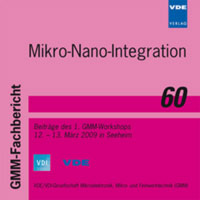Application of Carbon Nanotubes as Conductive Filler of Epoxy Adhesives in Microsystems
Conference: Mikro-Nano-Integration - 1. GMM-Workshops
03/12/2009 - 03/13/2009 at Seeheim, Germany
Proceedings: Mikro-Nano-Integration
Pages: 6Language: englishTyp: PDF
Personal VDE Members are entitled to a 10% discount on this title
Authors:
Heimann, Matthias; Rieske, Ralf; Telychkina, Oksana; Böhme, Björn; Wolter, Klaus-Jürgen (Technische Universität Dresden, Electronics Packaging Laboratory, Helmholtzstr. 18, 01069 Dresden, Germany)
Wirts-Ruetters, Martin (Fraunhofer Institute for Manufacturing Technology and Applied Materials Research, Bremen)
Abstract:
The fast growing development of the microelectronic industry permanently pushes the development and the improvement of the existing electronics packaging technologies, and also the development of new materials for electronics packaging. A lot of commonplace joint materials like solders can not meet the requirements for the future electronic applications, which tend to the miniaturization of electronic devices, high pin count up to 5000 I/Os per device, pitches down to 20 µm, higher current density per devices and higher thermal dissipation loss. The research of the new technologies and materials of the nanotechnology is needed to solve these problems. The aim of this project is to investigate the properties of conductive epoxy composites filled with carbon nanotubes (CNT) in order to improve the electrical, mechanical and thermal performances. Carbon nanotubes have excellent mechanical, thermal and electrical properties and the application of CNT as conductive fillers in epoxy adhesives promises high performance conductive adhesives for some conditions. To characterize the properties of carbon nanotube / epoxy composites in this study, we investigated adhesives with the modification of CNT under variation of the epoxy matrix and adhesives obtained with different dispersion technologies (ultrasonic bath, speed mixer, calender, ultrasonic finger). The influence of these parameters on viscosity, mechanical strength, thermal and electrical conductivity was studied and respective values were measured. Because the carbon nanotubes caused a significant increase in the viscosity of the adhesive, a low viscosity polymer matrix (< 100 mPas) was chosen. Multi-wall carbon nanotubes (MWNTs) were chosen for the experiments because these are available in favorable quantities and at reasonable prices. In order to enhance the dispersion properties, the MWNTs were also treated chemically via ozone/UV and low pressure plasma. The bonding to the polymer matrix was also improved. XPS and TEM images were analyzed to explore the successes of the study. Investigations of the dispersion technology showed the advantage of ultrasonic finger in achieving well dispersed CNT. The plasma treatment proved to be efficient for modification of the CNT due to appropriate amounts of hydroxyl groups. In this study we expected to develop electrical conductive adhesives filled with CNT for electronics packaging. The results show that CNTs significantly improve the performance of conducting adhesives for microsystems with regard to the mechanical strength and thermal conductivity, and can be used as a base for future improvements of electronics packaging technologies.


